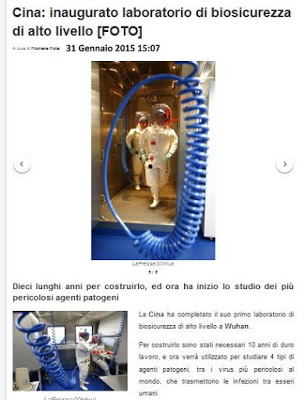Was the coronavirus created in a laboratory?
 |
| Elsa Mourgues 11/03/2020 |
Is it possible that men in a secret laboratory created this global epidemic? This is the question at the heart of Les Idées Claires (The Clear Ideas), our weekly programme produced by France Culture and franceinfo to fight against information disorders, from fake news to preconceived ideas.
Tradotto da Fausto Giudice
In the midst of the coronavirus crisis, a study conducted by researchers from two universities in New Delhi, India, has ignited social networks. The researchers claimed to have discovered amino acid sequences in certain coronavirus proteins that are found in… HIV.
The idea that Covid-19 was created by humans in a laboratory quickly spread. The rumour already existed at the time of SARS in 2003, the 2009 influenza A (H1N1), Ebola or even HIV itself. The study, which was not very rigorous, has since been removed from the website where it was hosted, but the questions remain: is there a secret laboratory in Wuhan, the region in China where the coronavirus was first identified? Is there a link to HIV? And are humans capable of creating a virus in a laboratory without leaving a trace?
These are all questions we asked Professor Olivier Schwartz, Scientific Director of the Pasteur Institute, head of the Virus and Immunity Unit.
Was the coronavirus created in a laboratory?
Prof. Olivier Schwartz: The coronavirus was not created in a laboratory. There are indeed rumours, as with every new epidemic. Some suspicious or outright paranoid people imagine the worst conspiracy theories, but we know that’s not the case.
But one study found traces of HIV in the coronavirus?
There is indeed a scientific study that has been deposited on a website where researchers can put their results. But these results have not been validated, they have not been examined by other teams and this was the case. A team of researchers has shown sequence homologies between this coronavirus and HIV, but in fact this is meaningless. The sequence of the virus is a sequence of basic nucleic acids, it’s 30,000 different letters that follow each other. 30,000 letters is about 30 pages of a book for example, and they compared those 30 pages to 30 pages of another book, about HIV. They found that there were groups of three or four letters in common. It’s as if in one novel they wrote the word “cat” and in another novel they also wrote the word “cat”, among tens of thousands of words. Statistically there are bound to be homologies, but it doesn’t matter, it’s just random.
But if that study was taken out, does this mean that it was disturbing?
Prof. Olivier Schwartz: Not at all. The authors of the study retracted, they withdrew their paper, because on this site there is a dialogue that is taking place with the scientific community and the majority opinion showed that it was completely due to chance and that the sequences were too small to suggest an origin or a mixture between HIV and the coronavirus.
What is the evidence that the human did not create covid-19?
Quite simply by sequence analysis. We now know how to analyse very precisely, by creating what we call phylogenetic trees. We can trace the origin of a virus and we know, for example in the case of this coronavirus, that it comes from a virus that is naturally present in certain animals, in certain bats and also in the pangolin. In these animals we can find the virus identical to almost 90 or 98% homology. Here we know that the virus has passed directly from the bat or the pangolin to human.
Was the virus created in a secret laboratory in Wuhan?
In the Wuhan region there is no secret laboratory, there is a laboratory called P4, there are some in France too. P4 [BSL-4 in the USA] means a certain level of security and for example in France or in Wuhan these laboratories are used to handle Ebola type viruses, it’s to protect the manipulators and the population.
Is it possible that scientists create a virus?
No, nature does it very well. It took hundreds, even thousands, even millions of years to create them, I’m thinking of endogenous retroviruses, for example, which were even a rudimentary form of life before the appearance of mammals certainly. In the laboratory we can do tests, but we’ll never do as well as nature did in those thousands, even millions of years.
Could we find out if a virus was created by humans?
Absolutely. The analysis of its genetic heritage would make it possible to understand the manipulations, if there were any. We could see an alignment of sequences or strange words that do not come from a natural process. But often when you introduce these kinds of modifications into a virus, it’s rather bad for the virus, good for humans, the virus is less able to multiply with these foreign additions in its own genome.


